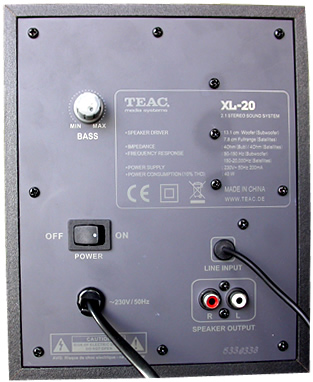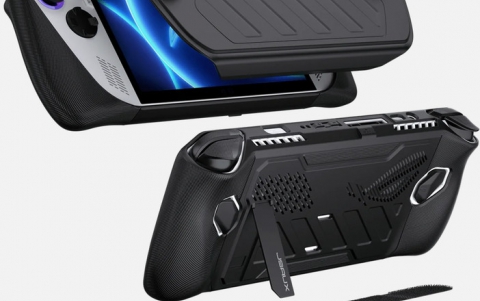Teac XL-20
1. Introduction
Obviously, a 2.1 system only reproduces stereo so you won't be able to get the benefits of 5.1 surround sound. While most music is still almost exclusively in stereo, it's really only an issue for DVDs and games where surround sound is a real plus. However, some 3D-sound simulation systems, while they can't really compete with a true surround system, can improve results. Multimedia 2.1 systems have become a lot better and offer real quality sound reproduction at a very accessible price.
We looked at and listened to a 2.1 system priced at under $40 from Teac, the XL-20. The Japanese company has always been known for their exceptional recording equipment, especially amongst recording industry professionals to whom they cater. In more recent times, TEAC's consumer products have been geared more towards the low end of the audio market.
With the XL-20 2.1 speaker set, TEAC focuses on the PC user who needs a
quality, yet affordable audio system. For all those who are not familiar
with 2.1 channel audio systems, the XL-20 consists of two satellite speakers
along with a subwoofer. Generally, the satellite speakers reproduce the high
and mid-range frequencies of an audio signal, which means that they are
responsible for the quality of vocals and music, or any other sound except
the bass. The latter is reproduced by the subwoofer, which is the speaker
for all the low frequencies of an audio signal. The quality of the subwoofer
is very important since it would determine whether the rocket-launcher and
grenade explosions in your games will rumble in your room with realism, or
the bass line and the kick drum rock the walls when you playback your
favorite songs.
 Looking at TEAC's XL-20 system, we would say that it really excels with its
space-age design. The magnetic-shielded subwoofer cabinet, looks solid and
its compact size allows it to easily fit under a desk or table. The inside
of the peaker driver hides a 13.1 cm woofer - large enough for good bass
response - that blasts up to 12 watts (RMS) of bass output although not
exactly what would make the floor tremble. The silver bass-reflex port
opening is the only opening on the subwoofer and is found on the front. TEAC
added some rubber feet at the bottom of the unit to help keep it firmly in
place.
Looking at TEAC's XL-20 system, we would say that it really excels with its
space-age design. The magnetic-shielded subwoofer cabinet, looks solid and
its compact size allows it to easily fit under a desk or table. The inside
of the peaker driver hides a 13.1 cm woofer - large enough for good bass
response - that blasts up to 12 watts (RMS) of bass output although not
exactly what would make the floor tremble. The silver bass-reflex port
opening is the only opening on the subwoofer and is found on the front. TEAC
added some rubber feet at the bottom of the unit to help keep it firmly in
place.
On the right side of the subwoofer, you will find a 3.5 mm stereo input jack and also the line-in cable that connects to your sound card (analogue stereo source). The same cable also leads to the wired remote control. One positive point here is the absence of an external power transformer, which would add a little more clutter to the mess of cables that are probably already dangling from your machine. All you need to power up the system, is to plug the power cable directly to a 230 volt~50Hz plug and press the Power ON switch, located on the right side. Lastly, you should connect the satellite (L&R) speakers to the corresponding speaker inputs, as well as a bass level control knob.

The two 2.54 cm Mylar Membrane full range satellites feature a small footprint
so they will easily fit either side of any monitor. Each satellite outputs
8 Watts (2 x 8 Watts) and feature a small bass reflex opening, as illustrated
in the photo below. In general, such openings improve the frequency response
of a speaker since it acts like a high-pass filter. Note
that the satellites are connected to the subwoofer unit through pluggable
connectors and not directly, allowing you to extend the length of the cables
in order to place the satellites away from your desktop.

As we previously mentioned, a wired remote control unit is on the input-line of the device, although it would be more convenient if it could be located somewhere between the two speakers. As you can see below, ergonomics is no problem - the unit looks quite stylish and is very easy to use. The big volume control knob is sensitive, while an easier to find mute knob would be very convenient. When the mute button is not enabled, a nice blue LED lets you know there is power going to the system. With the controls on a separate unit, it gives the satellite speakers a very clean look. What we should note is the headphone jack placed on the remote control. However, when you listen to music through the headphones, the audio lacks any real bass since the subwoofer is bypassed.

Features:
3 built-in amplifiers
Mylar membrane satellites
magnetic shielded subwoofer.
Control Panel Volume, Treble and Bass Control, Power Led
Technical specifications:
Peak power output: 70 W
Main supply 230 Volt~50 Hz, 0.12 A
Subwoofer
135 mm driver
Frequency range 50-150 Hz
Power output (RMS): 15 W
Dimensions (WxHxD): 158 x 200 x 286 mm
Satellites
Magnetic shielded Mylar Full Range
78 mm driver
Frequency range 150-20,000 Hz
Power output (RMS): 2 x 10 W
Dimensions (WxHxD): 95 x 160 x 108 mm
Accessories: Connection Cables, Wired Remote Control




















